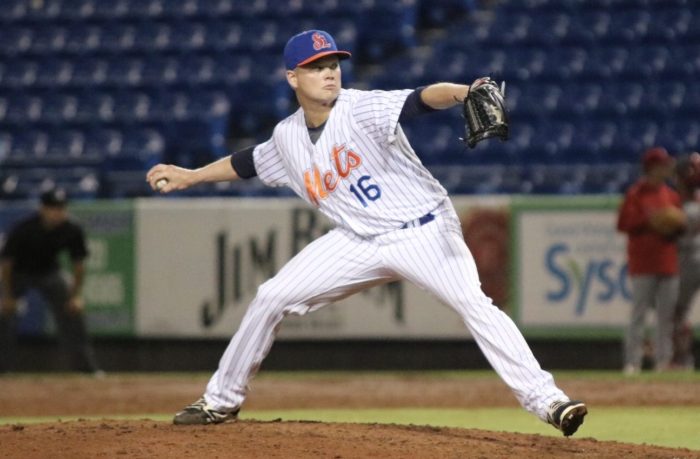
Ryder Ryan/Photo by Ed Delany, MMN
Due to a couple of trades and some shrewd drafting, the Mets have a talented crop of relievers inching towards the Majors Leagues. It’s possible that a few of them see time in the majors in 2019.
No. 5 Ryder Ryan
Age: May 11, 1995 (23) Bats/Throws: R/R 2018 Level: St.Lucie Mets(A+)/Binghamton Rumbles Ponies(AA)
Acquired: Acquired for Jay Bruce on August 9, 2017
2018 MiLB Stats: 4-3, 42 G, 53 IP, 3.23 ERA, 1.057 WHIP, 5 SV, 10 K/9, 2.5 BB/9.
Ryan’s a little bit of an enigma at this point. Acquired in exchange for Jay Bruce in August 2017, Ryan started 2018 strong, earning a promotion to Binghamton within the first two months of the season. However, he struggled with the Rumble Ponies pitching to a 4.13 ERA, a 4.31 FIP and 1.38 HR/9. That HR/9 represented a career high, a number that Ryan will need to lower in order to succeed at the upper levels of the minors. While Ryan’s typically been a fly-ball pitcher, he’ll need to learn how to keep the ball on the ground.
His fastball is in the mid-90’s, but he can dial it up to 97 at times. While his fastball doesn’t have much movement, he does well to throw on both sides of the plate and change hitters’ eye levels. His off-speed offerings include a mid-80s slider that functions as his main breaking pitch. He also throws a changeup, yet it’s used sparingly.
Over the years, Ryan’s gotten much better at limiting free passes and he posted a career-best mark in that regard in 2018. If Ryan learns to keep the ball on the ground, he could be an impactful MLB reliever as soon as 2020.
No. 4 Ryley Gilliam
Age: August 11, 1996 (22) Bats/Throws: R/R 2018 Level: Brooklyn Cyclones (A-)
Acquired: Drafted in the fifth round of the 2018 draft (140th overall)
2018 MiLB Stats:0-1, 17 G, 17 IP, 2.08 ERA, 1.38 WHIP, 5 SV, 16.10 K/9, 6.75 BB/9.
Gilliam’s an unusual case in that he was drafted as a pure reliever. Before being drafted by the Mets in the fifth round of the 2018 draft, Gilliam served as Clemson’s closer, accumulating 15 saves over the last three years. Gilliam also pitched for the USA National Collegiate team, where he didn’t give up a run in 8 1/3 innings, and the Cape Cod League.
Gilliam was drafted as a fast-moving reliever who could appear in the later innings for the big-league club in the next couple of years. He certainly has the stuff to feature prominently in a big-league role. His fastball-curveball combo that’s deadly in the bullpen. His fastball sits in the mid-90’s and Perfect Game had it as high as 97 once. Jim Callis of MLB.com also labeled his 12-6 curveball as being one of the best in the draft. His high-tempo and funky delivery is one of the main reasons for his control issues.
Callis of MLB.com named him as one of the 2018 draftees who could make a quick MLB impact. He was placed on the Brooklyn Cyclones’ roster to begin his pro career, which was strange for a player that the Mets should be promoting aggressively through the system. He pitched in 17 games for the Cyclones, posting a 2.08 ERA, a 16.1 K/9, and a 6.75 BB/9. His walk rate with the Cyclones shows that he still hasn’t been able to overcome his command issues which have plagued him at Clemson. Even though he should have played for a full-season ball team in 2018, he still should on the fast track to the Majors.
No. 3 Stephen Villines
Age: July 15, 1995 (23) Bats/Throws: R/R 2018 Level: Columbia Fireflies(A), St. Lucie Mets(A+), Binghamton Rumble Ponies (AA)
Acquired: Drafted in the tenth round of the 2017 draft (307th overall)
2018 MiLB Stats:5-4, 47 G, 66.2 IP, 3.11 ERA, 0.89 WHIP, 10 SV, 12.96 K/9, 1.76 BB/9.
Many people who follow the Mets Minor Leagues love Villines and once you see his windup, it’s easy to see why. If you have a thing for sidearmers, this is the perfect person for you.
Villines lines up on the first-base side of the rubber and then with a high leg kick, he proceeds to drag his arm behind his body, where he turns his wrist in a strange motion. The submariner throws two pitches, a fastball that sits in the high-80’s and a slider that averages in the mid-to-high 70s. Both pitches have above-average movement, which is a result of his deceptive, yet effective delivery.
Villines’ specialty is his ability to limit the free pass; he’s only allowed 14 walks in the two years he’s been in the Mets system. Throughout his minor-league career, he’s consistently posted strikeout rates above 30% and minuscule walk rates. He’s also done very well to induce tons of ground-balls.
He started 2018 strong in the Fireflies’ pen and earned himself a promotion to St.Lucie. He really shined in Lucie, allowing only a run in 22 innings. He spent the last month of the season with the Rumble Ponies. FIP and xFIP have loved Villines since his debut due to his ability to limit walks and homers. His 2.27 FIP with Binghamton in 2018 was the highest of his career. Since he reached Binghamton in 2018, he will most likely make his MLB debut in 2019.
No. 2 Daniel Zamora
Age: April 15, 1993 (25) Bats/Throws: L/L Level: Binghamton Rumble Ponies(AA), New York Mets(MLB)
Acquired: Sent to the Mets from the Pirates as a PTBNL in exchange for Josh Smoker
2018 MiLB Stats:1-1, 17 G, 40 IP, 3.48 ERA, 1.38 WHIP, 2 SV, 12.02 K/9, 2.79 BB/9.
2018 MLB Stats: 1-0, 16 G, 9 IP, 3.00 ERA, 1.00 WHIP, 0 SV, 16.00 K/9, 3.00 BB/9.
The return for Josh Smoker last winter provided the Mets with nine innings of three-run ball that showcased his tantalizing potential. Zamora’s not your typical LOOGY; he’s shown the ability to pitch more than one inning and opposite splits in the past.
With Binghamton in 2018, he pitched to an stellar 3.48 ERA, a 2.40 FIP, and a 12.02 K/9. His impressive season at Binghamton forced the Mets’ hand to give him a shot in September.
His arsenal consists of two pitches, which are both aided by his unique arm slot. His arm slot, which isn’t unlike Rich Hill’s, makes it extremely difficult for hitters to pick up the ball. Zamora throws from a low 3/4 slot that can make the most feared left hitter look silly. His fastball sits in the low-90s with a ton of movement thanks to his unique release point. But his slider is really his bread and butter. In his brief Major-League stint, he threw it a shocking 78.5% percent of the time and batters only hit .179/.250/.357 against it. The spin rate for his slider averaged 2640 RPM, which ranked 11th among relievers that appeared after Zamora’s debut.
#Mets added LH-RP Daniel Zamora to the 40-Man yesterday. Funky slot, tough slant to lefties, matchup guy w/ situational ceiling. Here's video from the @EasternLeague ASG this July. #LGM pic.twitter.com/Gdp5u6HIYi
— Adam McInturff (@2080adam) August 19, 2018
Even though the Mets used him mostly as a LOOGY in 2018, he can easily develop into the rare lefty reliever whose role is to retire more than one batter in an inning.
The Mets seem comfortable with Zamora starting in the Majors in 2019 and if they’re unable to acquire another left-hander for the pen, Zamora could play an integral role in 2019.
No. 1 Eric Hanhold
Age: November 1, 1993 (25) Bats/Throws: R/R Levels: Binghamton Rumble Ponies(AA), Las Vegas 51s(AAA), New York Mets (MLB)
Acquired: Sent to the Mets from the Brewers as a PTBNL in exchange for Neil Walker.
2018 MiLB Stats: 5-3, 35 G, 49 IP, 3.48 ERA, 1.28 WHIP, 8 SV, 10.40 K/9, 2.92 BB/9.
2018 MLB Stats: 0-0, 3 G, 2.1 IP, 7.71 ERA, 2.14 WHIP
Despite being one of the less-known relievers in the Mets farm system, Eric Hanhold has the highest ceiling out of any reliever. Once the Mets acquired him from the Brewers as part of the Neil Walker trade, the Mets strictly used him as a reliever and he began to dominate. Hanhold started 2018 strong and seemed positioned for a mid-season call-up. However, he hurt his oblique in mid-June, which brought his impressive season to a halt. He was called up as a September call-up, but he reinjured his oblique and was quickly shut down for the remainder of the year. Hanhold was selected to play as part of the Mets’ contingent to participate in the Arizona Fall League, but his oblique injury forced him to forego it.
The righty’s primary weapon is a power sinker that touches triple-digits. His repertoire also features a tight slider that sits in high-80s to low-90s. In the past, he’s shown a talent to induce ground-balls and although those numbers slipped in 2018, it’s still considered to be a strength.
Even though his injury-shortened 2018 campaign caused some concern, Hanhold’s a dominant force out of the pen if he can avoid further injuries. While he reached the Majors this year, his debut year definitely wasn’t one to remember due to nagging injuries. Nevertheless, he could feature prominently in the Mets bullpen for the next several years to come.
Editor’s Note
The argument to rank either Zamora or Eric Hanhold No.1 on this list split our MMN staff apart. Insults were hurled, expletives were exchanged, and the relationship of the MetsMinors.net staff was forever changed. It was a close vote, but at the end, Hanhold pulled away given his ceiling compared to that of Zamora.
Previous Rankings

